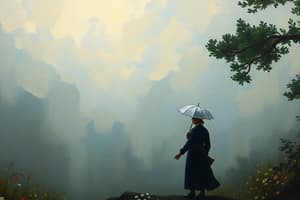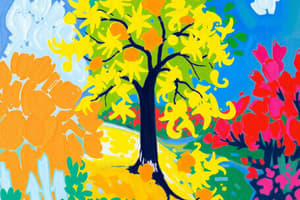Podcast
Questions and Answers
What is representation?
What is representation?
The use of language, marks, and images to interpret the world around us.
Which painting style depicts the same scene many times to evoke changes in light over time?
Which painting style depicts the same scene many times to evoke changes in light over time?
- Realism
- Surrealism
- Cubism
- Impressionism (correct)
Impressionist artists adhered strictly to the Academic style.
Impressionist artists adhered strictly to the Academic style.
False (B)
What are the two key concepts introduced by Roland Barthes in photography?
What are the two key concepts introduced by Roland Barthes in photography?
The Marlboro Man represents _____ in advertising.
The Marlboro Man represents _____ in advertising.
What does interpellation refer to in semiotics?
What does interpellation refer to in semiotics?
What is a primary characteristic of institutional critique?
What is a primary characteristic of institutional critique?
Flashcards are hidden until you start studying
Study Notes
Representation
- Representation is the process of using language, images, and marks to interpret the world
- Systems of representation mediate reality, they don't simply reflect it
- We experience the world through representations
- Systems of representation are structured by cultural rules and conventions
- These rules and conventions are flexible and changing
Realism and the Challenges to Perspective
- Human vision is more complex than a system of lines
- Our eyes are in constant motion when we look at things
- Our vision is a compilation of different views and glances
Impressionism
- Impressionist artists reacted against the constraints of the Academic art style
- They advocated for painting outdoors and chose to depict nature
- Impressionism artists studied the effects of light and atmosphere on people and objects
- Impressionist artists used varied colors to capture the actual colors of objects—local colors
- Impressionist artists juxtaposed complementary colors to produce optical vibrations
- Impressionist artists juxtaposed primary colors to create secondary colors in the spectator’s eye
More Challenges to Perspective
- Modern artists questioned the organization of the Cartesian subject as the center of the pictorial world
- Conceptual art: artistic practice that prioritizes concept over the visual product
- Fluxus artists, such as Yoko Ono, use chance by incorporating audience behavior into time-based performance art
The Myth of Photographic Truth
- Punctum: the affective dimensions of a photograph that “prick” us emotionally
- Studium: the qualities of a photograph that depict the conditions of its “take”
Semiotics and Signs
- We decode images almost instantaneously
- Clues in an image may point to intended, unintended, and merely suggested meanings
- Clues may be formal elements of an image or cultural and socio-historical contexts
- Semiotics: the theory of signs studies the ways words, images, and objects convey meaning
The Marlboro Man
- Marlboro (signifier) + masculinity (signified) = Marlboro as masculinity (sign)
Interpellation
- Interpellation is the way images cause us to recognize ourselves as subjects within a system of power
- Ideology interpellates individuals as subjects
- Collective address can feel personal
- Being hailed by an ideology may involve rejecting it
Value, Collecting, and Institutional Critique
- Images and objects don’t have inherent value
- Objects are given monetary, social, and political value in specific social contexts
- The value of an art object can be based on:
- Authenticity and uniqueness
- Reproducibility and role in popular culture
- Previous ownership
- Museums, institutions, and individual collectors are responsible for the valuation of art works
- They communicate value through the display of artwork
- They shape looking practices
Institutional Critique
- Artists began creating work called Institutional Critique
- After creating Fountain, Marcel Duchamp became the celebrity of Dada, a movement that parodied the conventions of high art and museum display
- Dada influenced many movements that aimed to criticize the art market and its valuing of art collecting:
- Political art
- Guerilla art
- Performance art
- Happenings
- Situationists
- Fluxus
- Street art
- These movements created art that could not be easily commodified as valuable objects
Studying That Suits You
Use AI to generate personalized quizzes and flashcards to suit your learning preferences.




